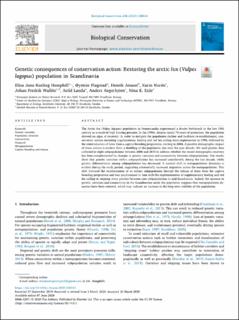| dc.contributor.author | Hemphill, Elisa June Keeling | |
| dc.contributor.author | Flagstad, Øystein | |
| dc.contributor.author | Jensen, Henrik | |
| dc.contributor.author | Norén, Karin | |
| dc.contributor.author | Wallén, Johan Fredrik | |
| dc.contributor.author | Landa, Arild Magne | |
| dc.contributor.author | Angerbjörn, Anders | |
| dc.contributor.author | Eide, Nina Elisabeth | |
| dc.date.accessioned | 2021-01-18T13:55:17Z | |
| dc.date.available | 2021-01-18T13:55:17Z | |
| dc.date.created | 2020-07-23T10:13:01Z | |
| dc.date.issued | 2020 | |
| dc.identifier.citation | Biological Conservation. 2020, 248 . | en_US |
| dc.identifier.issn | 0006-3207 | |
| dc.identifier.uri | https://hdl.handle.net/11250/2723528 | |
| dc.description.abstract | The Arctic fox (Vulpes lagopus) population in Fennoscandia experienced a drastic bottleneck in the late 19th century as a result of high hunting pressure. In the 1990s, despite nearly 70 years of protection, the population showed no signs of recovery. In order to mitigate the population decline and facilitate re-establishment, conservation actions including supplementary feeding and red fox culling were implemented in 1998, followed by the reintroduction of foxes from a captive breeding programme, starting in 2006. A positive demographic impact of these actions is evident from a doubling of the population size over the past decade. We used genetic data collected in eight subpopulations between 2008 and 2015 to address whether the recent demographic recovery has been complemented by changes in genetic variation and connectivity between subpopulations. Our results show that genetic variation within subpopulations has increased considerably during the last decade, while genetic differentiation among subpopulations has decreased. A marked shift in metapopulation dynamics is evident during the study period, suggesting substantially increased migration across the metapopulation. This shift followed the recolonization of an extinct subpopulation through the release of foxes from the captive breeding programme and was synchronized in time with the implementation of supplementary feeding and red fox culling in stepping stone patches between core subpopulations in mid-Scandinavia. Indeed, the increase in genetic variation and connectivity in the Scandinavian arctic fox population suggests that metapopulation dynamics have been restored, which may indicate an increase in the long-term viability of the population. | en_US |
| dc.language.iso | eng | en_US |
| dc.publisher | Elsevier | en_US |
| dc.rights | Navngivelse 4.0 Internasjonal | * |
| dc.rights.uri | http://creativecommons.org/licenses/by/4.0/deed.no | * |
| dc.title | Genetic consequences of conservation action: Restoring the arctic fox (Vulpes lagopus) population in Scandinavia | en_US |
| dc.type | Peer reviewed | en_US |
| dc.type | Journal article | en_US |
| dc.description.version | publishedVersion | en_US |
| dc.source.pagenumber | 12 | en_US |
| dc.source.volume | 248 | en_US |
| dc.source.journal | Biological Conservation | en_US |
| dc.identifier.doi | 10.1016/j.biocon.2020.108534 | |
| dc.identifier.cristin | 1820276 | |
| dc.relation.project | Norges forskningsråd: 244557 | en_US |
| dc.relation.project | Norges forskningsråd: 223257 | en_US |
| dc.description.localcode | This is an open access article distributed under the terms of the Creative Commons CC-BY license, which permits unrestricted use, distribution, and reproduction in any medium, provided the original work is properly cited. | en_US |
| cristin.ispublished | true | |
| cristin.fulltext | original | |
| cristin.qualitycode | 2 | |

